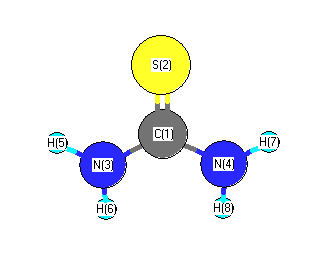Vibrational Frequencies calculated at SVWN/TZVP
| Mode Number |
Symmetry |
Frequency
(cm-1) |
Scaled Frequency
(cm-1) |
IR Intensities
(km mol-1) |
Raman Act
(Å4/u) |
Dep P |
Dep U |
|---|
| 1 |
A |
3617 |
3576 |
28.76 |
|
|
|
| 2 |
A |
3486 |
3446 |
11.31 |
|
|
|
| 3 |
A |
1574 |
1556 |
117.62 |
|
|
|
| 4 |
A |
1387 |
1372 |
256.11 |
|
|
|
| 5 |
A |
1048 |
1036 |
25.16 |
|
|
|
| 6 |
A |
770 |
761 |
8.87 |
|
|
|
| 7 |
A |
462 |
456 |
10.43 |
|
|
|
| 8 |
A |
445 |
440 |
6.67 |
|
|
|
| 9 |
A |
274 |
271 |
91.88 |
|
|
|
| 10 |
B |
3616 |
3574 |
77.15 |
|
|
|
| 11 |
B |
3475 |
3435 |
48.04 |
|
|
|
| 12 |
B |
1564 |
1546 |
339.64 |
|
|
|
| 13 |
B |
1431 |
1414 |
19.98 |
|
|
|
| 14 |
B |
1009 |
998 |
11.32 |
|
|
|
| 15 |
B |
617 |
610 |
0.61 |
|
|
|
| 16 |
B |
575 |
568 |
61.11 |
|
|
|
| 17 |
B |
389 |
385 |
7.06 |
|
|
|
| 18 |
B |
364 |
359 |
357.42 |
|
|
|
Unscaled Zero Point Vibrational Energy (zpe) 13052.0 cm
-1
Scaled (by 0.9885) Zero Point Vibrational Energy (zpe) 12901.9 cm
-1
See section
III.C.1 List or set vibrational scaling factors
to change the scale factors used here.
See section
III.C.2
Calculate a vibrational scaling factor for a given set of molecules
to determine the least squares best scaling factor.
Charges, Dipole, Quadrupole and Polarizability
Charges from optimized geometry at SVWN/TZVP
Charges (e)
| Number |
Element |
Mulliken |
CHELPG |
AIM |
ESP |
| 1 |
C |
0.004 |
|
|
|
| 2 |
S |
-0.250 |
|
|
|
| 3 |
N |
-0.400 |
|
|
|
| 4 |
N |
-0.400 |
|
|
|
| 5 |
H |
0.278 |
|
|
|
| 6 |
H |
0.245 |
|
|
|
| 7 |
H |
0.278 |
|
|
|
| 8 |
H |
0.245 |
|
|
|
Electric dipole moments
Electric dipole components in Debye
(What's a Debye? See section
VII.A.3)
| |
x |
y |
z |
Total |
| |
0.000 |
0.000 |
-5.099 |
5.099 |
| CHELPG |
|
|
|
|
| AIM |
|
|
|
|
| ESP |
|
|
|
|
Electric Quadrupole moment
Quadrupole components in D Å
| Primitive |
|---|
| | x | y | z |
|---|
| x |
-34.925 |
1.862 |
0.000 |
| y |
1.862 |
-25.549 |
0.000 |
| z |
0.000 |
0.000 |
-28.844 |
|
| Traceless |
|---|
| | x | y | z |
|---|
| x |
-7.729 |
1.862 |
0.000 |
| y |
1.862 |
6.336 |
0.000 |
| z |
0.000 |
0.000 |
1.393 |
|
| Polar |
|---|
| 3z2-r2 | 2.785 |
|---|
| x2-y2 | -9.376 |
|---|
| xy | 1.862 |
|---|
| xz | 0.000 |
|---|
| yz | 0.000 |
|---|
|
Polarizabilities
Components of the polarizability tensor.
Units are
Å
3 (Angstrom cubed)
Change units.
| |
x |
y |
z |
| x |
4.256 |
0.135 |
0.000 |
| y |
0.135 |
7.208 |
0.000 |
| z |
0.000 |
0.000 |
10.215 |
<r2> (average value of r
2) Å
2
| <r2> |
101.111 |
| (<r2>)1/2 |
10.055 |
